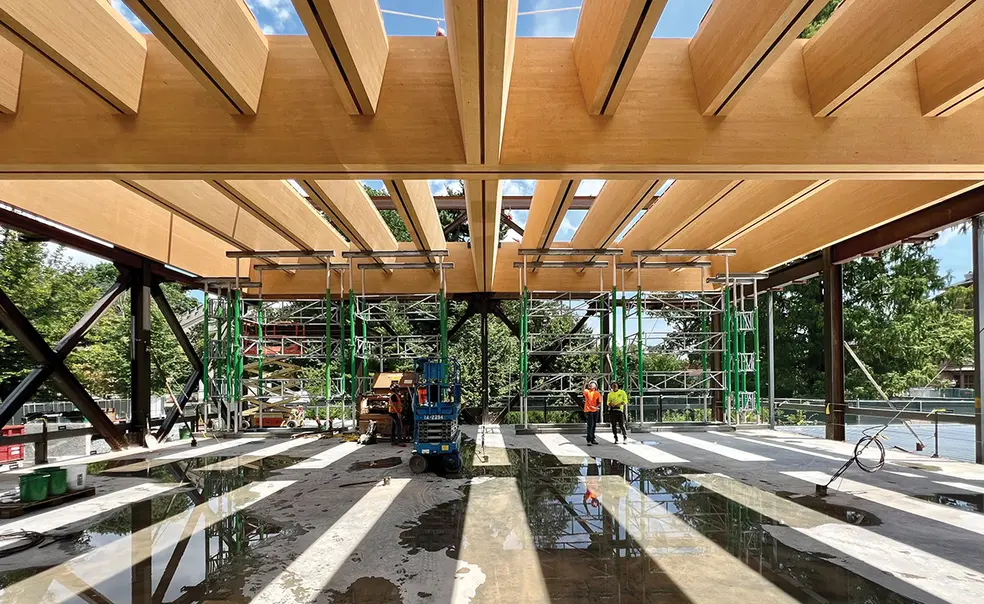Seeking Sustainability in Buildings, Princeton Invests in Mass Timber
The University is in the midst of the steepest spike in campus expansion since the early 1960s, with 16 projects currently under construction and targeted for completion by 2029.
“It’s certainly not growth for growth’s sake — it’s really to meet the mission of the institution,” said University Architect Ron McCoy *80, citing the strategic initiatives to increase access for undergraduate students, further commit to the highest level of research and scholarship, and meet campus sustainability goals.
A notable aspect of the current construction that touches on the latter of those initiatives is the use of a certain building material: mass timber, a building technology in which layers of wood are laminated, glued, nailed, or doweled together. Mass timber has been around since the 1990s but has risen in prominence recently since it’s considered a more sustainable building material.
McCoy said there are about 800 buildings in North America that use mass timber, so the University’s six mass timber projects, which include the Environmental Studies and School of Engineering and Applied Science complex and Hobson College, will add several buildings to that tally.
Most of the projects are more completely built using mass timber, while the art museum has a mass timber structure in the ceiling, and the Frist Health Center has a hybrid structure incorporating steel and mass timber. “It’s a kind of learning curve for us; more recent projects are more fully mass timber,” McCoy said.
McCoy said his team came to the decision to use mass timber as part of its sustainability efforts, since the University has a goal to be carbon neutral by 2046. One way to achieve that, he said, is to “attack embodied carbon” — or the amount of energy required to extract materials from the earth, create building materials, transport them, and erect them on the site. According to McCoy, mass timber is low in embodied carbon, making it a more sustainable material than materials high in embodied carbon such as steel and concrete.
Whether mass timber is actually better for the environment is up for debate, though. Tim Searchinger, a senior research scholar at the School of Public and International Affairs’ Center for Policy Research on Energy and the Environment, said that he thinks the use of mass timber in construction is a “mistake.”
In recently published research in the journal Nature and separately for the World Resources Institute, Searchinger and his co-authors argued that there’s a misunderstanding about the effect that global wood harvests are having on the storage of carbon: Many assume it is carbon neutral when that may not be the case. The researchers found that using wood in construction, even when compared to concrete and steel, is likely to increase emissions for many decades.
While Searchinger admitted that there isn’t a “completely clean solution” to building materials, he added, “It pains me, frankly, to walk around and see this error in action.”
The University’s Office of Sustainability participates in the design of every building project and helps to evaluate the material choices made for each project. The office’s interim director, Ijeoma Nwagwu, said she has seen critiques of mass timber, but the choice to use it was supported by the Sustainability Advocacy Committee’s review.
“We’re not taking on these sustainable efforts just on their face value — we do a lot of studies internally as well as in consultation with our contractors and consultants to make sure that we’re choosing the best option,” Nwagwu said. “Sometimes there is no perfect option, but we do really take seriously any critiques around any of our material choices.”
Nwagwu and McCoy noted that the University works with suppliers that harvest the wood “responsibly,” including taking into account environmental impact and labor practices.
“As future generations look back, they’ll be able to see the time when the University made this dramatic commitment to sustainability,” McCoy said. “You know, all of a sudden you snap your fingers and there’s a whole generation of mass timber buildings and sustainable building materials that’ll appear on campus. That’ll mark this commitment that the University has to sustainability.”












No responses yet